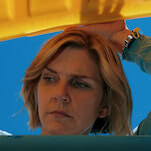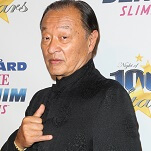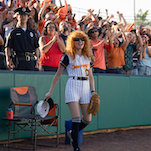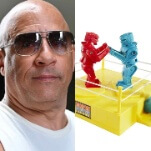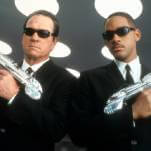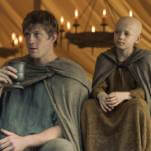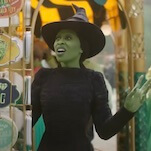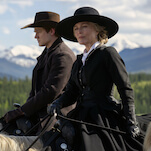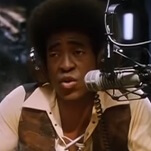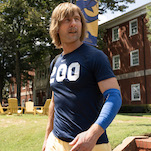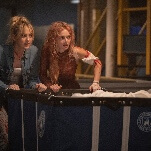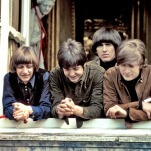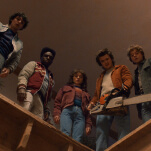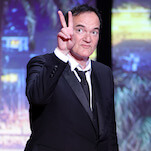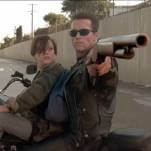Despite a mixed critical reception, Man Of Steel made $125 million this past weekend, breaking the record for a June opening and putting the $84.6 million five-day opening of 2006’s Superman Returns to shame. Warner Bros. got exactly what it wanted, so much so that the studio has fast-tracked a sequel that could hit theaters as early as next year. Superman is a cultural force to be reckoned with again, but why does this development feel like such a loss for the character?
Reviews have described Zack Snyder’s film as “steroidal”, “humorless”, and “cold” (comic book writer/Superman super-fan Mark Waid’s review is spot-on), but this is the version of Superman that is going to be around for the foreseeable future. To my eyes, Man Of Steel combines the repetitive sci-fi spectacle of John Carter with the senseless real-world destruction of Transformers, showing brief glimpses of a better movie in the character development it poaches from Christopher Nolan’s Batman films. The film is dedicated to making sure all the “super” comes across onscreen via arduous action sequences, but it’s better when it focuses on the “man,” particularly in Clark Kent’s scenes with his parents. Diane Lane and Kevin Costner steal the show, but no one is paying $14 to watch Ma and Pa Kent in action.
While Man Of Steel is a hit with audiences, critics have been less favorable; the film has a 55 percent score on Metacritic and a certified rotten 56 percent on Rotten Tomatoes. By comparison, Superman Returns scored 72 percent on Metacritic and 75 percent on Rotten Tomatoes, but an homage to Richard Donner’s Superman films didn’t fly with a public that had become accustomed to more down-to-earth heroes like Spider-Man, the X-Men, and a newly reimagined Batman. The movies that have ignited the box office in the past few summers have been collateral damage-heavy films like The Avengers, Transformers, Iron Man, and Nolan’s Batman trilogy, so Zack Snyder and writer David S. Goyer pushed their Superman reboot in that direction. Special-effects technology has advanced to the point where films can match comic books in depicting the destructive force of a superhero battle, and it’s just not a superhero movie anymore if a major urban center isn’t left in shambles.
Audiences have a morbid curiosity for disaster-porn (I admit I saw Transformers: Dark Of The Moon to find out what Michael Bay would do to my home city of Chicago), and by the end of Man Of Steel it looks like a nuclear bomb has been dropped on Metropolis. Entire buildings have fallen on screaming pedestrians as Superman and General Zod toss each other through the city’s skyline, but everything’s going to be just fine because Superman saved Lois Lane for the nth time. It’s a film full of special effects-heavy set pieces, beginning with a raging battle on Krypton and ending with a raging battle on Earth, but beyond the scenes with Ma and Pa Kent, it doesn’t feel like a Superman movie. The shield on the hero’s chest could be replaced by just about any insignia, because while Goyer and Snyder hold on to Superman’s basic origin story, they sacrifice integral parts of his character to move the film’s tone closer to Christopher Nolan’s grittier superhero vision.
Superman has seemingly infinite power, but he’s only an interesting character when there are limitations placed on him. When Superman was first introduced, he had restrictions. Most notably, he couldn’t fly, but instead had the ability to leap tall buildings in a single bound. His civilian identity as Clark Kent put extra limits on the hero, forcing him to keep his Superman persona a secret from his deepest friends and the woman he loved. Kryptonite was introduced in the Adventures Of Superman radio serial, making the character’s greatest weakness an element that only exists on his home world because on-the-nose symbolism was all the rage back in 1943.
These restrictions help humanize a godlike character, and up until the 21st century, Superman’s portrayal outside of comic books has benefited from the technological limitations of popular entertainment. Two years after debuting in 1938’s Action Comics #1, Superman experienced a surge in popularity thanks to The Adventures Of Superman, which had the extreme restrictions of radio. It’s useless to spend an extended period of time depicting action through only sound, so the show emphasized Clark’s civilian job at the Daily Planet and his relationships with professional rival Lois Lane, his pal Jimmy Olsen, and curmudgeonly editor Perry White. These stories required the audience to use their imaginations for the action and forced the writers to focus on the characters, captivating a broad audience that kept the show running for 11 years.
Adventures Of Superman ended in 1951, one year before an identically titled series debuted on television with George Reeves in the title role. There was now the added visual element, but TV presented its own unique challenges. As Noel Murray describes in his “100 Episodes” piece on the series, “[Adventures Of Superman] was more like a dirt-cheap police procedural sprinkled with a few minutes of unconvincing special effects.” The show would run for six years and air 104 episodes, proving that while the superhero elements of the characters might be what draws in younger comic-book readers, it’s the trials of Clark Kent that keep an audience captivated, giving him challenges that can’t be solved by heat vision and ice breath. Superman would later find small-screen success with Smallville, a series that lasted 10 seasons by turning Clark Kent’s story into a teen drama. It’s hard to tell a superhero beat-’em-up on a TV budget, so creative teams have to approach the character from a different angle in order to make him work in that medium.
Two decades after the end of Superman’s TV series, Richard Donner brought the character to the big screen for his very first full-length feature film. (He had previously appeared in cinemas in cartoon shorts and two live-action serials.) Thanks to technological advances, Donner’s films were closer to the tone of the comic books than any previous Superman project, portraying a hero that had the ability to move the San Andreas Fault and turn back time by flying backwards around the Earth. Yet even with all that power, Donner’s version of Superman still has restrictions. He’s incredibly fast but it still takes him some time to get from one place to another, and when he’s in a fight, he doesn’t send people hurtling 20 city blocks with one punch.
There are still plenty of special-effects limitations in Donner’s films, so the relationship between Lois and Clark is put at the center of the plot, creating a superhero romance that remains unmatched to this day. Christopher Reeve and Margot Kidder have electric chemistry, and the playful flirtation of Lois and Clark’s encounters on the job informs their relationship when Clark is in costume. The scenes in the Daily Planet are essentially superhero foreplay in Donner’s films, coming to a head in Superman II when Superman gives up his Kryptonian biology so that he can take his woman to bed. Adding that massive limitation to Clark’s character makes the victory at the end of the film all the more satisfying, even with a lackluster final battle between Superman and his enemies.
Bryan Singer’s Superman Returns is so heavily indebted to Donner’s films that it’s nearly a parody, but its attempts to modernize the hero’s situation are misguided and diminish the character. Returning to Earth after disappearing for five years to find out if his home planet survived (it didn’t), Superman is shocked to find that Lois Lane has moved on with her life. She’s engaged to a handsome pilot, has a young son, and won a Pulitzer Prize for writing a piece about why the world doesn’t need Superman—but that doesn’t stop our hero from trying to win her over. He spies on her at home and takes her on a romantic rooftop flight while her fiancée and son wait for her downstairs, trying to win her back when he’s completely at fault for abandoning her five years ago and leaving her with a super-powered kid.
Superman the Deadbeat Dad, an absurd supervillain plot, and the lack of chemistry between leads Brandon Routh and Kate Bosworth prevent Superman Returns from reaching its potential, but at least Singer’s film tries to bring a sense of fun and optimism to the proceedings, even with the heavy-handed Jesus metaphors. (Man Of Steel goes all-out with those; at one point, Clark’s face shares the frame with a stained-glass image of Jesus, and later Superman falls to Earth posed like Jesus on the cross.) There’s an increase in the superhero action thanks to 21st-century CGI, but Singer gives himself considerable limitations by using Donner’s films as a guiding influence. The ill-advised developments in Lois and Clark’s relationship tarnish what could be a delightful superhero film, but at least it’s not the generic alien-invasion flick that is Man Of Steel.
Goyer and Snyder’s Superman is a force of nature, but watching him is about as captivating as staring at an avalanche. The spectacle is awe-inspiring at first, but it gets increasingly repetitive the longer you watch. The heroism of the character is lessened by the fact that he insists on fighting in heavily populated areas instead of flying over the ocean or a cornfield, and barring a few exceptions, the only person Superman is focused on protecting is Lois. That central romance becomes very shallow without the tension presented by the Clark Kent secret identity, and their big kiss after the climactic final battle elicits laughter instead of cheers. Then there’s the final controversial moment between Superman and General Zod, establishing once and for all that this version of Superman truly has no limits. Clark Kent throws on his glasses and takes a job at the Daily Planet in the final moments of the movie, but the slog to get to that point doesn’t inspire much confidence for the future of this franchise. Superman’s sheer physical power has never been captured as effectively as it is in Man Of Steel, but a sense of vulnerability is essential in creating a character that isn’t as lifeless as a hunk of metal.

